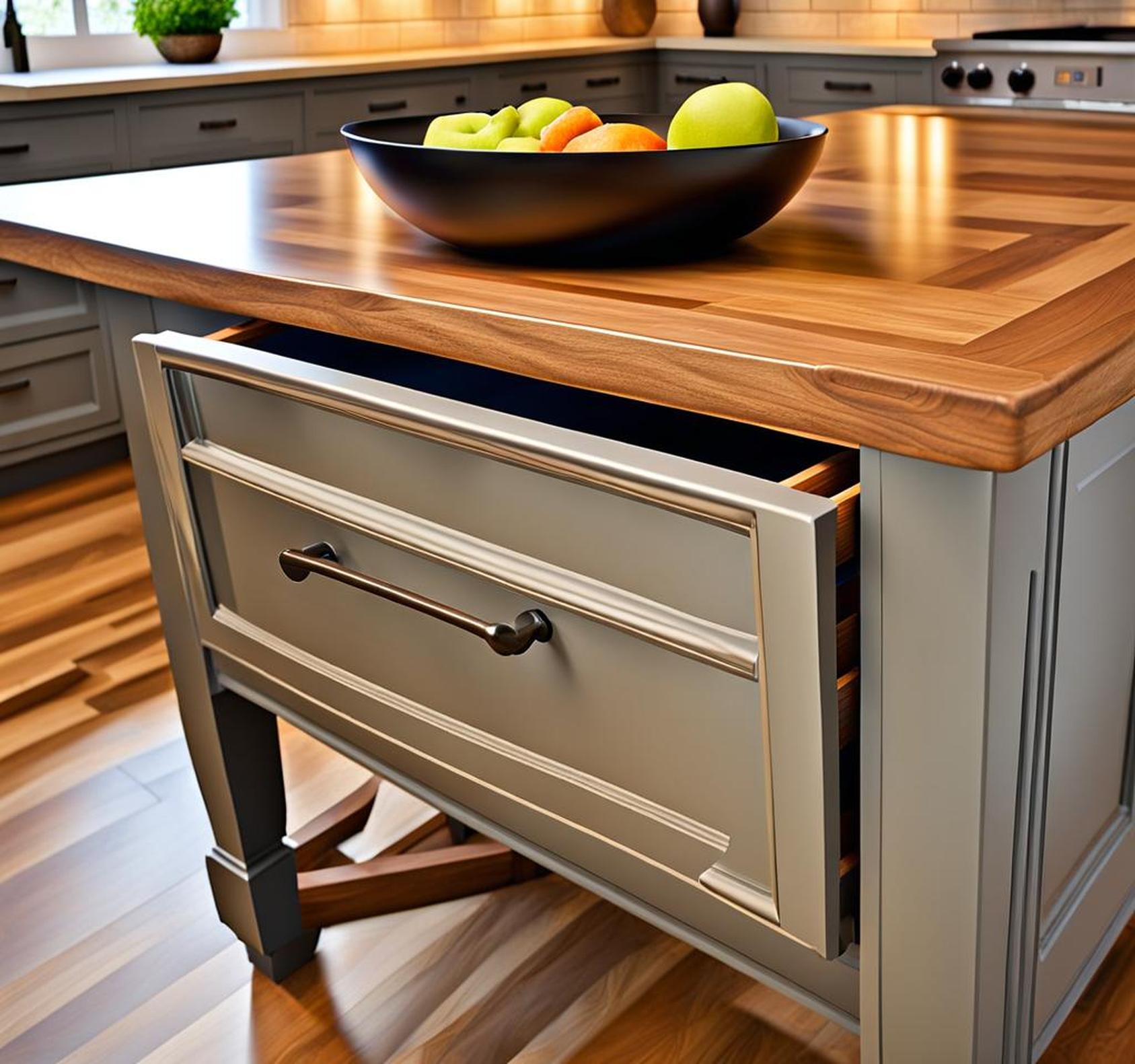Kitchens are often the heart of a home, but they can also be a source of clutter and disorganization if storage space is limited. This is where drawer side tables, sometimes called end tables, can make all the difference by providing extra storage and surface area in a compact, multifunctional piece of furniture.
What are Drawer Side Tables?
Drawer side tables are small free-standing tables that feature storage drawers built directly into the base. They are designed specifically for placement against walls, corners, and other tight spaces within kitchens and dining rooms.

Unlike larger kitchen islands and rolling carts , drawer side tables don’t take up much floor space. Their diminutive size lets them tuck neatly out of the way when not in use, making them perfect for small kitchens.
Benefits of Using Drawer Tables in Kitchens
- Provide extra storage and organization solutions without claiming precious floor area
- Add much-needed countertop space for food prep and serving
- Act as a handy side table next to dining chairs
- Multifunctional piece can also be styled as a decorative end table
Choosing the Right Kitchen Drawer Table
Not all drawer side tables are created equal. When selecting one for your kitchen, consider the following factors:
Measure Available Space
First, scrutinize your kitchen layout and measure potential areas where you could place a drawer table. Make sure to account for not just the table’s footprint, but also surrounding space needed to fully open drawers without obstruction. Also assess corners and high-traffic zones to determine ideal positioning.
Match Table Style to Your Kitchen
These compact tables are available in an array of materials and designs catering to differing decor tastes. Options include farmhouse, industrial, mid-century, and modern styling. Choose a table that aligns with your kitchen’s current aesthetic and color scheme for a cohesive appearance. Contrasting or matching textures and finishes can also make the piece a decorative focal point.
Select Durable, High-Quality Materials
Durability is key when choosing materials since these tables need to withstand regular use and cleaning. Wood, metal, tempered glass, and marble tabletops paired with sturdy leg supports are all resilient options suited for the wear-and-tear of kitchen environments. Seek out smoothly gliding drawer slides as well for an enhanced user experience.
Determine Storage Needs
Not all drawer side tables are the same depth or configurated interiorly. Assess what you intend to store within the table’s compartments. Deep drawers suit bulky objects like large cookware and small appliances, while shallow ones neatly corral flatware, linens, or spices. Removable interior organizational trays also enhance utility. Some tables even have specialized features like stemware holders, towel bars, or racks.
Ideal Drawer Table Placement
Properly positioning your new drawer side table is key to maximizing its functionality.
Near Food Preparation Zones
For avid home cooks, placing the table directly next to key food prep areas provides convenient access to essential cooking tools. Keep go-to utensils, oils, spices, and condiments in the top drawers for a simplified cooking process. This also reduces kitchen clutter since everything has a dedicated storage spot when not in use.
Adjacent to Dining Spaces
Positioning the compact table near dining sets streamlines serving and entertaining. Store tableware, linens, and serving utensils in the drawer interiors, then utilize the tabletop as a holding area for cooked dishes, beverages, or decor during meals. The built-in storage helps keep dining spaces tidier.
Tucked Into Empty Corners
Sometimes awkward, angular spaces get ignored when designing kitchen layouts. But it’s precisely these unused voids and gaps along walls or between cabinets that make perfect homes for versatile drawer side tables. Take advantage of the dead space while angled or rounded table silhouettes meld cozily into corners.
Styling Your Drawer End Table
Aside from adding storage and surface area, drawer side tables also provide ample decorating and design opportunities. Have fun dressing up your table with these suggestions:
Use Interior Organizers
Tap into a drawer table’s storage potential by using crates, trays and baskets to neatly corral gadgets, utensils and other odds and ends. Clear organizers let you view contents at a glance while keeping items sorted.
Style the Tabletop
Since drawer side tables will likely sit flush against kitchen walls, the tabletop becomes a blank decorating canvas. Style it with floral centerpieces, fruit-filled bowls, sleek candleholders, or arty sculptures for quick visual impact.
Add Functional Flair
For a more modern twist, accessorize the top with metallic wire knife blocks , geometric-shaped pepper mills , or potted herb gardens rooted in pretty planters. The integrated functionality looks aesthetic while also being handy for everyday kitchen tasks.
More Tips for Using Drawer Tables
To maximize usefulness from your compact side table, keep these additional pointers in mind:
Install Casters for Mobility
Mounting caster wheels on the base allows you to conveniently reposition the table as needed. Lock the wheels once located in the ideal spot to prevent shifting during use. This adjustable versatility also future-proofs the piece if you later remodel your kitchen layout.
Seek Specialty Features
Charging stations , handy electrical outlets , under-cabinet task lighting , adjustable-height components, and removable tray inserts are just some of specialized add-ons now integrated into modern drawer side tables. See what specialty amenities are important to your kitchen workflow.
Proper Care and Cleaning
Follow material-specific care instructions to protect your investment piece. Use cutting boards and trivets to safeguard tabletops when prepping. Immediately blot spills, drips and debris. Routinely clean surfaces to avoid stains, but use gentle cleaners intended for more sensitive materials like wood or marble.
By now the benefits of installing a drawer side table in your kitchen should be clear. These adaptable pieces provide abundant storage solutions , bonus countertop real estate for cooking and serving, and design style all while maximizing unused space in smaller kitchen layouts. Let these multitasking powerhouses simplify your culinary workflow while simultaneously adding decor flair.
